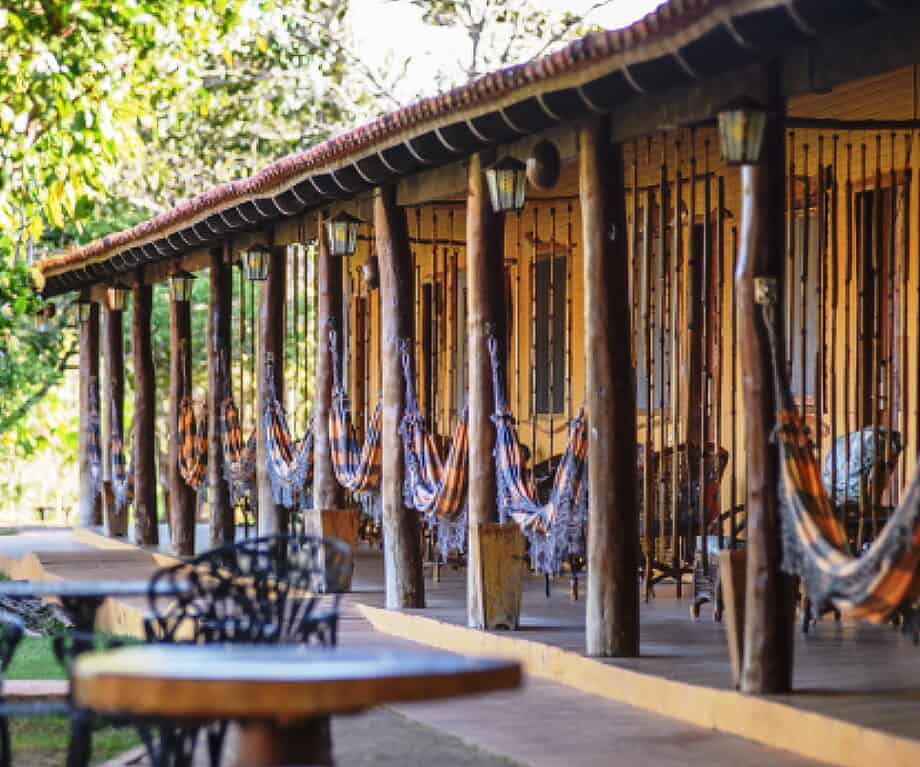The Pantanal?” people ask. Even many well-traveled adventurers are oblivious to what the Pantanal really is – despite it being the largest tropical wetland on earth, bigger than the UK.
Once called “Brazil’s Best Keep Secret,” for only about 10 years have tourists been visiting this wellspring of biodiversity in any numbers. Fortunately, though, it’s now becoming one of the top destinations for wildlife watching in South America.

Here we look at just a few of the most salient features that make this amazingly diverse ecosystem such a captivating travel destination.
A biodiversity hotspot: For a front-row seat to wildlife drama
The vast Pantanal wetland is now considered South America’s most outstanding wildlife-watching destination, second only to the Galapagos Islands. Although the species of animals and wildlife you’ll come across are like those deep inside the nearby Amazonian rainforest, it’s much easier to spot the creatures here as they live in a much wider open area.

For those wanting to view big cats in the wild, Pantanal is one of the best places to find the elusive jaguar, particularly during the June-to-October dry season; this is when water levels are low and animals are forced to congregate around shrinking water sources, making sightings more frequent and spectacular.
During the dry season, you’ll also have a good chance to spot groups of exotic-looking capybara, and giant river otters – great muscular mammals almost the size of a human. As motionless caiman sun themselves on the riverbanks and howler monkeys roar while swinging from tree to tree, you’ll experience the marvelous menagerie that is the Pantanal.

For birdwatching, the Pantanal is a utopia with more than a thousand species of our feathered friends. Many tourists always have the lively hyacinth macaw high on their list of things to see in the wild. These brilliant blue birds — the largest flying parrots in the world — add streaks of color to the lush green landscape. Other iconic birds encountered in the wetlands include the lanky Jabiru (“swollen neck”) Stork and vibrantly colorful toucans.
The best way to explore Pantanal’s bio-diverse environment is via guided tours led by local experts. This not only increases the chance of spotting hard-to-see animals, but it also ensures safer and less harmful interactions with mother nature These excursions are provided by boat, jeep, horseback, and even on foot, enlightening visitors about diverse wildlife in that region.
For adventurous wildlife enthusiasts, the Pantanal offers an unforgettable experience, presenting stunning views that are difficult to find anywhere else.
Pantanal cultural experiences: Broadening perspectives
Though more famous for its incredible biodiversity, the Pantanal also provides a glimpse of people’s lives in this largely untouched part of rural Brazil. In the Pantanal, you’ll discover a rich stew of cultures that can further elevate any trip with a better understanding of how human societies adapt to their immediate local environments.

A slice of the culture for which the Pantanal is famous can be observed by visiting or even staying at one of the area’s working cattle ranches, called fazendas. In these Wild West parts of the region, a trip to one of these homesteads will give you a taste of this old-time cowhand lifestyle and provide the chance for some small-town hospitality.

The trip also offers a way to learn about the indigenous cultures. Engaging with local communities — even partially or for short periods — will help you understand their lifestyle; this can be experienced and seen through their sustainable fishing and farming practices and their age-old techniques for creating intricate handicrafts. What’s more, you can even participate in their rousing festivals. Taking part in these cultural exchanges not only enhances the travel experience but also serves to keep indigenous knowledge and traditions alive.
From eco- to upscale accommodations
From the relatively minimalist eco-lodges to glamorous resorts, accommodations in the Pantanal are varied.
Eco-lodges are increasingly more in fashion and the Pantanal is one of the most sought-after locations, mixing simplicity with comfort. Many of these lodges are located in more remote areas encouraging travelers to get a real feel for the natural splendor surrounding them. Many of these accommodations also provide guests with guided bird-watching tours, wildlife safaris, boat excursions, and other activities.

Eco-lodges are an integral part of sustainable tourism in the Pantanal as they’ve been designed with sustainability in mind. This is evidenced by their use of renewable energy sources, water conservation methods, and creative waste management systems. As learning about conserving their unique ecosystems is crucial, many eco-lodges support conserving their environment locally through educational programs for guests.
Staying at a working ranch (a fazenda, as mentioned) exposes one to the unique and authentic socio-cultural experiences of the Pantanal. Lodging at a working ranch offers a unique blend of adventure and tranquility. You’ll experience authentic cowboy life of horseback riding and cattle herding by day, and spend peaceful evenings under the stars, immersing yourself in nature and rural culture on this unforgettable getaway.

For people looking for more comfort and amenities, upscale resorts can be found in this area too. Guests at these more fashionable retreats get higher-end accommodations, great fine dining, and a range of recreational activities. These resorts usually provide guided tours and wildlife excursions, ensuring a well-rounded experience.
Everything you need to plan your trip in 2024
Adventure activities: Off the beaten path to discover the unknown
Wildlife-watching excursions offer thrilling, front-row encounters with the wetland’s most iconic inhabitants. For up-close sightings of some of the wetland’s most incredible species, travelers typically head out on these adventures by boat, on foot, or in a 4×4 jeep.

For a more traditional experience, visitors can explore the wetlands on horseback, the same way pantaneiros (Pantanal cowboys) have been doing for centuries. Even those who’ve never ridden on horseback can saddle up a well-trained mount to explore and access remote parts of the wetlands, allowing an even closer connection to the landscape and its inhabitants.

Pantanal canoeing and kayaking are more soothing yet still thrilling exercises that bring you face-to-face with nature while being touched by the serenity of this expansive ecosystem. While on the water, you can even try your hand at piranha fishing. The challenge of hooking these infamous fish not only offers insight into wetland life, it also gives you a chance to enjoy a traditional meal.

All and all, the Pantanal is a playground of adventure activities that set travelers up for some captivating experiences in one of our planet’s most remarkable regions.
Pantanal ecotourism: Keeping it clean, keeping it green
As with many natural wonders, the Pantanal is threatened by climate change and human activities such as deforestation, and unsustainable tourism practices (such as littering, wildlife encounters without proper supervision, and excessive commercialization that erodes local ways of life).

Sustainable tourism is therefore imperative to reduce those negative environmental impacts on the Pantanal’s fragile environment. Additionally, it means maximizing the economic benefits of local communities while not compromising their culture.
In the Pantanal, some practical sustainable tourism steps include staying at eco-friendly lodges that support wildlife conservation, minimize waste, and utilize renewable energy. They also offer low-impact activities like wetlands canoe trips, birding tours, and other activities that least disturb the local wildlife.

There is also community tourism, whereby travelers interact with local people from Pantanal. Tourists who hire indigenous guides or eat at resident-owned restaurants in the Pantanal are helping to sustain the area by putting money directly into those communities.
Actions like this help to protect the Pantanal’s environment and help the local communities. Visiting the Pantanal sustainably ensures that this incredible ecosystem remains a vibrant destination for future generations to explore and cherish.
Photographic opportunities: Turn moments into masterpieces
Whether you’re a professional photographer or simply a photo hobbyist, the Pantanal offers great chances the Pantanal provides endless opportunities for shots emanating from one of the world’s most singular and vibrant ecosystems. Your memory of this extraordinary natural wonder is preserved every time the shutter clicks.

The Pantanal is a wonderland for wildlife and birdwatching photographing. As the area boasts the greatest number of jaguars in the world, it offers you the possibility of photographing these elusive predators against the backdrop of their natural habitat. Likewise, being inhabited by howler monkeys, giant otters, capybaras, caimans, and millions of birds, the wetlands are a haven for such forms of photography.

Plus, landscape and still-life photography in the Pantanal are themselves at par with wildlife camerawork. The constantly changing scenery of extensive wetlands, serpentine rivers, forests, and open savannas provide ample opportunities for that perfect click.

Several nature-friendly Pantanal photography tours are available, each accompanied by guides who know where the flora and fauna of the Pantanal should be found. All these tours are designed to minimize any possible environmental damage, leaving the beauty of wetland nature untouched.
The bottom line: The untamed beauty of the Pantanal wetlands is calling
The Pantanal is an incredible travel destination that combines a rare triptych: amazing wildlife encounters, cultural richness, and stunning landscapes. Whether you’re an avid wildlife lover, a devoted birdwatcher, or someone simply seeking adventure, this vast wetland has something for everyone.

By being a responsible tourist and properly planning for your visit, you will experience the wonders of the Pantanal while supporting its conservation. Pack your bags, get ready for an adventure, and have a go at uncovering the magic of this world’s largest tropical wetland area!
Did you enjoy this article?
Receive similar content direct to your inbox.
Please enable JavaScript in your browser to submit the form


